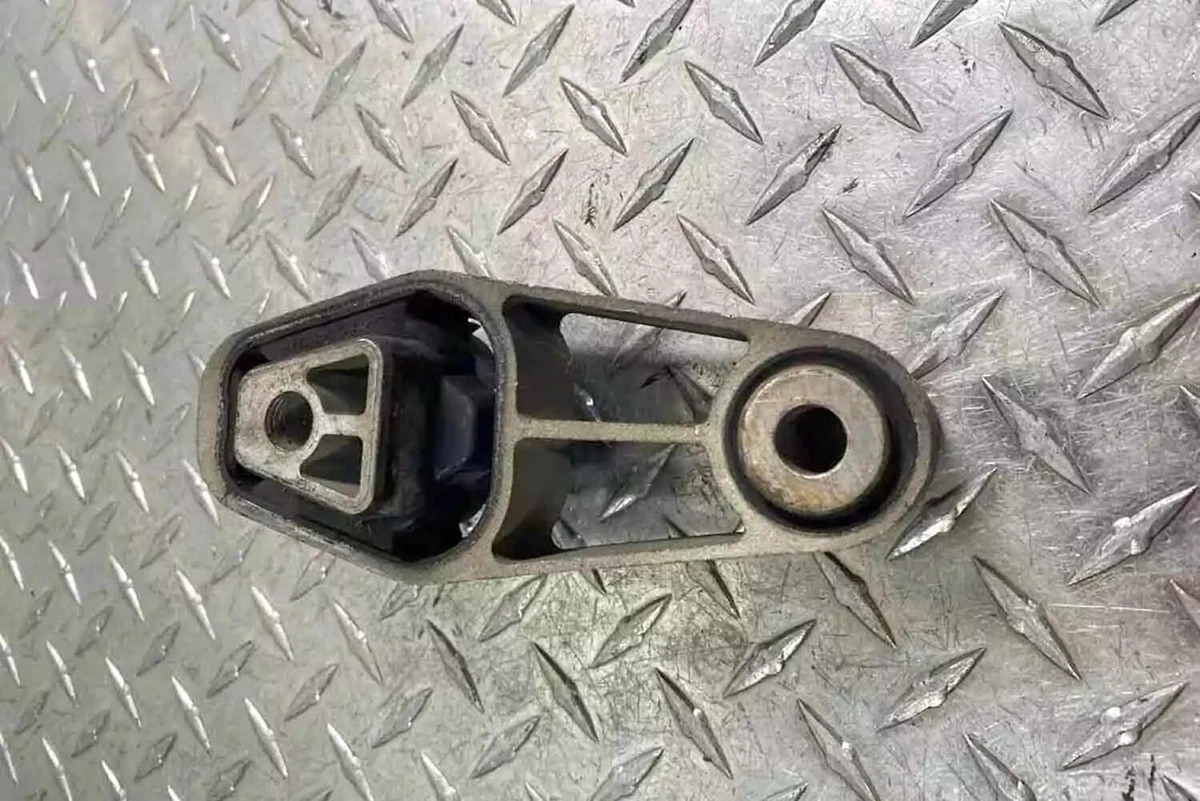
Transmission mount designs vary widely. This mount fits 2007-2015 MINI Coopers.
Transmission mounts secure the transmission to the chassis. They are comparable to engine mounts that secure the engine. The main function of transmission mounts is to produce a smoother, quieter ride—absorbing and minimizing vibrations from the road and other driving dynamics. These mounts also keep the transmission aligned.
Because the mounts hold the transmission in place, stress on other drivetrain components is also reduced. Excessive vibration could lead to related mechanical issues that increase wear and the likelihood of repairs.
How many transmission mounts does your vehicle have?
The average car usually has one to three transmission mounts. Front-wheel drive cars usually have two, especially if the transmission and engine are positioned transversely. A rear-wheel-drive vehicle might only have one. Heavy-duty vehicles could have more—as many as four, some of which might also help mount the engine—to add stability.
How long do transmission mounts last?
Transmission mounts aren’t typically replaced as part of regular maintenance. They don’t wear out often. Most transmission mounts last more than five years or about 60,000 miles. These mounts fail due to vibration and oxidation over time. However, rough driving conditions and extreme weather can accelerate wear.
Signs of Bad Transmission Mounts

If you feel a strange vibration at a stop light and when taking off, a bad transmission mount might be the culprit.
When the mounts start to fail, you suddenly feel more vibration than normal, especially when idling or accelerating. There could also be banging or clunking as the transmission moves around. These are more common when the gears shift, or there’s a sudden change in speed.
If the transmission isn’t properly secured by the mounts, gear shifts could become rough. This results from the transmission being out of alignment. You might also hear strange noises when traveling in reverse.
A visual inspection can easily reveal a bad mount. Watch for the transmission tilting or otherwise moving during acceleration. You will need a friend to help you with the inspection. While sitting behind the wheel, your helper should put one foot on the brake pedal and give the engine a small amount of gas with the transmission in drive or reverse. Then, you can visually inspect the movement of the transmission to see if there’s excessive vibration or other odd activity.
Can you drive with a bad transmission mount?
It’s a bad idea to drive more than a few miles, if that, with a bad transmission mount. Not only can it lead to a misaligned transmission, which can result in damaged gears, but it can strain other drivetrain components, such as the shift linkages, driveshafts, and CV joints.
Can a bad mount cause transmission failure?
Yes. If left unrepaired, a bad mount can indirectly lead to a failed transmission. The mount will not directly cause the immediate demise of the transmission. But vibrations will continue to add strain. Also, when a mount fails, the transmission becomes misaligned. The seals and gaskets can begin to crack and leak, which also results in overheating or grinding gears.
Learn how to replace a transmission mount with our step-by-step guide and video. It’s an intermediate-level DIY job that takes one to two hours.
Transmission Mount Replacement Cost

Transmission mounts are vehicle-specific.
Replacement transmission mounts on eBay cost between about $25 and $100. For example, a 2013-2019 Nissan Sentra mount listed for $70, while a 2014-2017 Jeep Cherokee mount was on sale for $45. Many of the prices include free shipping, and some companies offer warranties. Prices are higher for OEM transmission mounts and those designed for performance and luxury models.
If you have a shop replace your transmission mounts, it will add about $100 to $200 in labor —plus a markup on parts.
Besides parts, you will need some basic tools, such as jack, jack stands, socket wrenches, and a pry bar. With some vehicles, specialized tools may be required based on the specific model.
What Other Parts Should Be Replaced With Transmission Mounts?

Transmission and engine mounts work hand-in-hand to stabilize the drivetrain.
The first thing to do when replacing transmission mounts is to inspect the entire area to ensure optimal performance. The transmission and engine mounts work hand-in-hand to stabilize the drivetrain, so also check engine mounts.
Exhaust hardware is also located near the transmission and can endure strain from the irregular movement of the faulty transmission and/or engine mounts. Replace exhaust components if they are worn or loose, as seen from a visual inspection.
If you are maintaining your transmission at the same time, it could be time to
replace the transmission fluid
- opens in new window or tab.
, which should be changed every 40,000 to 100,000 miles. We also recommend a full inspection of the driveshaft and U-joints on a rear- or all-wheel drive vehicle. These parts experience faster wear if the transmission is misaligned.
Share your feedback
This article is meant to provide general guidance only. Automotive maintenance, repair, upgrade, and installation may depend on vehicle-specifics such as make and model. Always consult your owner's manual, repair guide for specific information for your particular vehicle and consider a licensed auto-care professional's help as well, particularly for advance repairs.
































